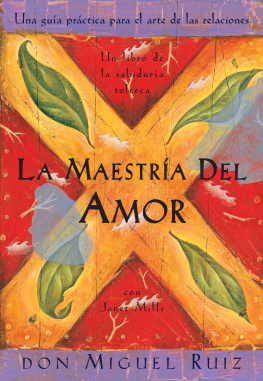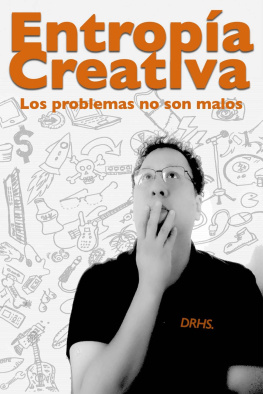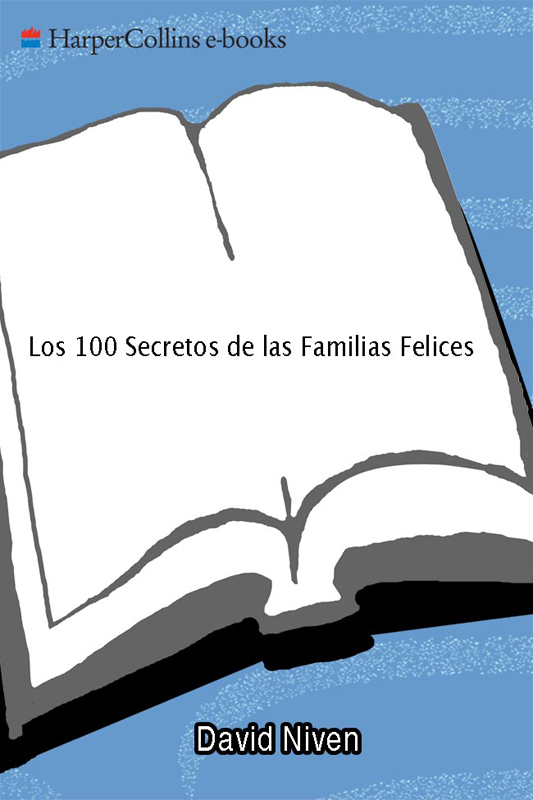DAVID NIVEN, PH.D., es el autor de los bestsellers internacionales Los 100 Secretos de la Gente Feliz, Los 100 Secretos de la Gente Exitosa, Los 100 Secretos de las Parejas Felices, y Los 100 Secretos de la Gente Saludable. Es psicólogo y científico social y enseña en Florida Atlantic University.
Adams, J. 2001. “Young People and Their Plans for Combining Career and Family Plans: How Realistic Are They?” Ph.D. diss., Virginia Commonwealth University, Richmond, Virginia.
Al-Abbad, W. 2001. “Adolescents’ Perceptions of the Stepparent Role and Their Role: How It Impacts Adolescent Adjustment to Living in Stepfamilies and Their Academic Achievement.” Ph.D. diss., Universidad de Arizona, Tucson, Arizona.
Altus, D., P. Xaverius, R. M. Mathews, y K. Kosloski. 2002. “Evaluatign the Impact of Elder Cottage Housing on Residents and Their Hosts.” Journal of Clinical Geropsychology 8: 117–l37.
Ardelt, M., y L. Day. 2002 “Parents, Siblings, and Peers: Close Social Relationships and Adolescent Deviance.” Journal of Early Adolescence 22: 310–349.
Asidao, C. 2002. “Exploring Variables Associated with Interracial and Intraracial Couples’ Relationship Satisfaction.” Ph.D. diss., Universidad de Illinois, Champaign, Illinois.
Atienza, A., M. Stephens, y A. Townsend. 2002. “Dispositional Optimism, Role-Specific Stress, and the Well-Being of Adult Daughter Caregivers.” Research on Aging 24: 193–217.
Baird, T. 2002. “The Effects of Parental Self-Disclosure and Connection on Parent-Child Relationship Satisfaction and Their Effects on Child Social Initiative and Child Self-Esteem.” Ph.D. diss., Univerisdad de Brigham Young, Provo, Utah.
Baronet, A. 2003. “The Impact of Family Relations on Caregivers’ Positive and Negative Appraisal of Their Caretaking Activities.” Family Relations 52: 137–142.
Baum, L. 2002. “Factors Related to Use of Internet Parent Support Groups by Primary Caregivers of a Child with Special Health Care Needs.” Ph.D. diss., Universidad de Utah, Salt Lake City, Utah.
Blanchfield, S. 2002. “The Structure of the Relationship Between Fathers and Their Gifted Daughters That Is Supportive of Giftedness: A Grounded Theory.” Ph.D. diss., Iowa State University, Ames, Iowa.
Bouazzaoui, B., y E. Mullet. 2002. “ Employment and Family as Determinants of Anticipated Life Satisfaction: Contrasting Young Adults’ and Elderly People’s Viewpoints.” Journal of Happiness Studies 3: 129–152.
Brady, E. M., y H. Sky. 2003. “Journal Writing among Older Adults.” Educational Gerontology 29: 151–163.
Brussoni, M. 2001. “We Are Family: Sibling Attachment Relationships among Young Adults.” Ph.D. diss., Universidad de British Columbia, Vancouver, British Columbia.
Burns, A., y R. Dunlop. 2002. “Parental Marital Quality and Family Conflict: Longitudinal Effects on Adolescents from Divorcing and Non-Divorcing Families.” Journal of Divorce & Remarriage 37: 57–74.
Busboom, A., D. Collins, M. Givertz, y L. Levin. 2002. “Can We Still Be Friends? Resources and Barriers to Friendship Quality after Romantic Relationship Dissolution.” Personal Relationships 9: 215–223.
Bussolari, C. 2002. “The Relationship among Interparental Conflict, Animal Bonding, Intimate Relationship Satisfaction and Attachment Dimensions in Adulthood.” Ph.D. diss., Universidad de San Francisco, San Francisco, California.
Buysse, T. 2000. “The Mother-Daughter Relationship and the Development of Daughters’ Feminist Consciousness.” Ph.D. diss., Wright Institute, Berkeley, California.
Caughlin, J. 2003. “Family Communication Standards: What Counts as Excellent Family Communication and How Are Such Standards Associated with Family Satisfaction?” Human Communication Research 29: 5–40.
Cesare, E. 2000. “Who Do Expectant Grandparents Perceive as Their Role Model for Grandparenthood: Grandparents or Parents?” Ph.D. diss., Universidad de Adelphi, Garden City, Nueva York.
Christensen, F., y T. Smith. 2002. “What Is Happening to Satisfaction and Quality of Relationships Between Step/Grand-parents and Step/Grandchildren.” Journal of Divorce & Remarriag 37: 117–133.
Coco, E. L., y L. Courtney. 2003. “A Family Systems Approach for Preventing Adolescent Runaway Behavior.” Family Therapy 30: 39-50.
Colarossi, L. 2001. “Adolescent Gender Differences in Social Support: Structure, Function and Provider Type.” Social Work Research 25: 233–241.
Compan, E., J. Moreno, M. T. Ruiz, y E. Pascual. 2002. “Doing Things Together: Adolescent Health and Family Rituals.” Journal of Epidemiology & Community Health 56: 89–94.
Cosbey, S. 2001. “Clothing Interest, Clothing Satisfaction and Self-Perceptions of Sociability, Emotional Stability and Dominance.” Social Behavior & Personality 29: 145–152.
Coyne, M. 2001. “Differences in Real and Ideal Love in Adult Children of Divorce.” Ph.D. diss., Universidad de Hofstra, Hempstead, Nueva York.
Crawford, D., R. Houts, T. Huston, y L. George. 2002. “Compatiability, Leisure, and Satisfaction in Marital Relationships.” Journal of Marriage & Family 64: 433–449.
Crosnoe, R., y G. Elder. 2002. “Successful Adaptation in the Later Years: A Life Course Approach to Aging.” Social Psychology Quarterly 65: 309–328.
Davidson, D., Z. Luo, y M. Burden. 2001. “Children’s Recall of Emotional Behaviors, Emotional Labels, and Nonemotional Behaviors: Does Emotion Enhance Memory?” Cognition & Emotion 15: 1-26.
Diener, E., R. Lucas, S. Oishi, y E. Suh. 2002. “Looking Up and Down: Weighting Good and Bad Information in Life Satis-faction Judgments.” Personality & Social Psychology Bulletin 28: 437–445.
Dorfman, D. 2001. “The Impact of Mother’s Work on the Life Choices and Sense of Self of the Young Adult Daughter During Motherhood: A Self Psychological Perspective.” Ph.D. diss., Universidad de Nueva York, Nueva York, Nueva York.
Eaker, D., y L. Walters. 2002. “Adolescent Satisfaction in Family Rituals and Psychosocial Development: A Developmental Systems Theory Perspective.” Journal of Family Psychology 16: 406–414.
Elek, S., D. Hudson, y M. Fleck. 2002. “Couples’ Experiences with Fatigue During the Transition to Parenthood.” Journal of Family Nursing 8: 221–240.
Enright, K. 2001. “Family Factors and Self-Esteem in Gifted Versus Nongifted Children.” Ph.D. diss., Seton Hall University, South Orange, Nueva Jersey.
Erdwins, C., L. Buffardi, W. Casper, y A. O’Brien. 200l. “The Relationship of Women’s Role Strain to Social Support, Role Satisfaction, and Self-Efficacy.” Family Relations 50: 230–238.
Fiese, B., T. Tomcho, M. Douglas, K. Josephs, S. Poltrock, and T. Baker. 2002. “A Review of 50 Years of Research on Naturally Occurring Family Routines and Rituals: Cause for Celebration?” Journal of Family Psychology 16: 381–390.
Fisk, A. 2002. “Can Marital Interaction Predict Women’s Relapse after Dieting?” Ph.D. diss., Alliant International University, San Diego, California.
Foust, M. 2002. “An Investigation of the Antecedents of Lateness Behavior: The Effects of Attitudes, Individual Differences, and Context.” Ph.D. diss., Universidad de Akron, Akron, Ohio.
Fox, G., y C. Bruce. 2001. “Conditional Fatherhood: Identity Theory and Parental Investmen Theory as Alternative Sources of Explanation of Fathering.” Journal of Marriage & the Family 63: 394–403.
Gable, S., and M. Hunting. 2001. “Child Care Providers’ Organi-zational Commitment: A Test of the Investment Model.” Child & Youth Care Forum 30: 265–281.












